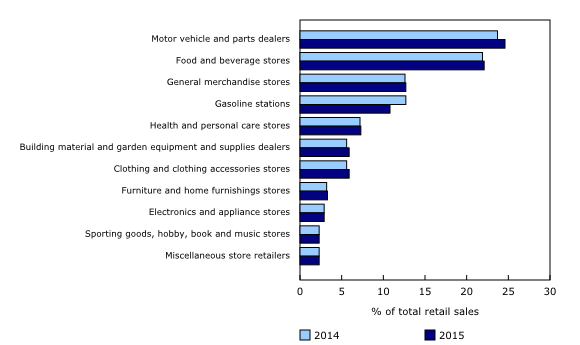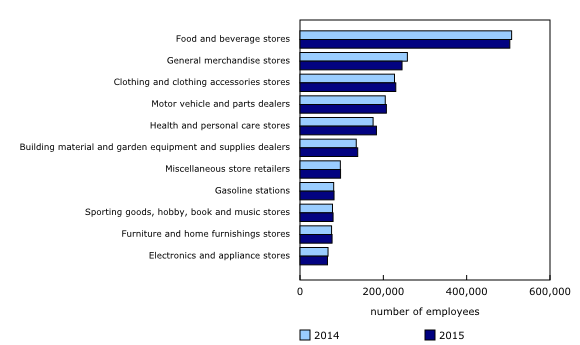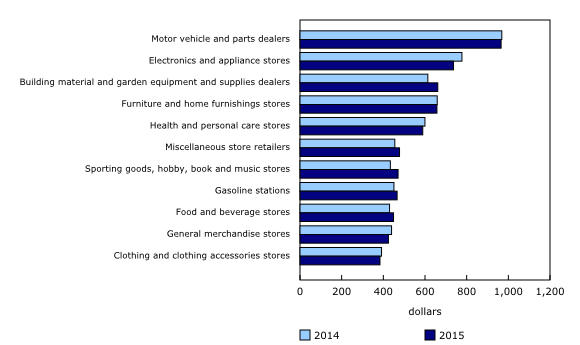Retail trade annual review, 2015
Archived Content
Information identified as archived is provided for reference, research or recordkeeping purposes. It is not subject to the Government of Canada Web Standards and has not been altered or updated since it was archived. Please "contact us" to request a format other than those available.
Released: 2016-09-19
Consumers spent $513.4 billion in retail stores in 2015, up 1.7% from 2014. Gains were reported in 9 of 11 subsectors and in seven provinces.
As in 2014, motor vehicle sales represented the largest share of total retail sales, followed by food. In 2015, growth in sales of used motor vehicles was greater than the gain in sales of new motor vehicles.
Automotive fuel sales continued to decline throughout the year, down 16.2% in 2015. Sales at gasoline stations accounted for 10.8% of the retail dollar, the lowest proportion since 2009, when they represented 10.1%.
Building materials and garden equipment and supplies dealers recorded their largest increase since 2006. Higher sales of lumber and other building materials were the main contributor.
New and used vehicles lead growth in sales
Motor vehicle and parts dealers' sales rose 5.5% in 2015. In dollar terms, new car dealers (+5.9%) recorded the largest gain within the subsector. Used car dealers (+11.8%) and other motor vehicle dealers (+3.0%) also increased in 2015. Automotive parts, accessories and tire stores declined 1.1%.
In 2015, sales of new motor vehicles were up 5.5% compared with 2014, according to the New Motor Vehicle Sales Survey. This gain was attributable to higher sales of new trucks (+10.0%). The number of cars and trucks sold hit a record high in 2015, totalling 1,935,184 units. Overall, 2.6% more units were sold in 2015 than in 2014.
Sales of used automotive vehicles rose a record 13.9% from 2014 to 2015. In 2015, sales of used automotive vehicles represented 34.2% of total motor vehicle sales, the highest proportion since 2009 (35.2%).
Less bread for a loonie
Retail sales at food and beverage stores increased 2.3% in 2015, largely as a result of rising prices for food. According to the annual average Consumer Price Index, consumers paid 4.1% more for food purchased from stores in 2015 compared with 2014.
Supermarkets and other grocery stores (+1.4%) recorded the largest sales gain within the subsector. Beer, wine and liquor store sales advanced 5.0% in 2015. Higher receipts were also reported at convenience stores (+4.5%) and specialty food stores (+1.1%).
In 2015, food accounted for 17.7% of total retail store sales, up slightly from 17.4% in 2014.
Building material and garden equipment and supplies dealers post largest gain since 2006
Sales at building material and garden equipment and supplies dealers rose 7.7% in 2015, the subsector's largest sales gain since 2006. Hardware, lawn and garden products were up 8.6% in 2015, led by lumber and other building materials (+9.1%), and plumbing, heating, cooling, and electrical equipment and supplies (+13.0%). According to the Consumer Price Index, the homeowners' maintenance and repairs index (+2.8%) accelerated in 2015, following a 1.0% increase in 2014.
Building material and garden equipment and supplies dealers increased their market share for hardware, lawn and garden products by 1.3 percentage points in 2015, while general merchandise stores posted a decline of a 1.4 percentage points in the market share for the same commodity group.
Increases in home building contributed to stronger sales for this subsector. According to the monthly Building Permits Survey, the number of new residential construction permits rose 1.1% in 2015.
Record gain at clothing and clothing accessories stores
Clothing and clothing accessories stores posted a record annual gain of over $2 billion (+7.4%) in 2015, because of higher volumes sold. About half of the increase was attributable to women's clothing and accessories (+7.8%), led by women's skirts, pants, blouses, sweaters, and other articles of clothing. Footwear (+9.5%) also contributed significantly to the annual rise in this subsector, as a result of higher sales of non-athletic footwear (+11.6%).
Fuel sales decline for most of 2015
Gasoline stations continued the sales decline that began in late 2014, recording sales decreases in eight months in 2015. Total sales at gasoline stations fell 13.9% in 2015, led by a 16.6% drop in automotive fuel sales. The decrease was largely price-driven, as the volume of gasoline sold was stable.
In the fourth quarter of 2015, automotive fuel sales represented 8.6% of total retail sales, the lowest level since the fourth quarter of 2009, when automotive fuel sales accounted for 8.5% of total retail sales.
According to the Consumer Price Index, consumers paid 16.5% less for gasoline in 2015 than in 2014. This marked the largest decrease in the gasoline price index since 2009.
Electronics and appliance stores continue downward trend
After posting a 1.3% increase in 2014, sales at electronics and appliance stores were down 0.4% in 2015, the third decrease in four years. Lower sales of televisions and audio/video equipment (-10.2%), and computer hardware and software (-3.8%) were the largest contributors to the decline.
Retail sales increase in seven provinces
Retail sales in Ontario increased for the sixth consecutive year, up 4.2% in 2015. The rise was led by higher sales at new car dealers (+13.6%), supermarkets and other grocery stores (+3.7%), and building material and garden equipment and supplies dealers (+8.4%).
Retail sales advanced 6.0% in British Columbia. Higher sales were posted at new car dealers (+11.1%), building material and garden equipment and supplies dealers (+19.5%) and supermarkets and other grocery stores (+5.5%).
Receipts in Quebec (+0.5%) were up for the sixth consecutive year, on the strength of higher sales at new car dealers (+6.3%), clothing stores (+9.7%), and health and personal care stores (+4.2%).
Sales in Manitoba (+1.5%) rose for the sixth consecutive year. The advance was primarily due to higher sales at new car dealers (+5.9%) and health and personal care stores (+14.5%).
In the Atlantic provinces, sales gains were reported in Newfoundland and Labrador (+0.2%) and New Brunswick (+2.4%) on the strength of higher sales at new car dealers and health and personal care stores. Higher receipts were posted in Prince Edward Island (+2.3%), while sales decreased in Nova Scotia (-0.6%) in 2015.
For the first time in three years, Alberta (-4.6%) recorded the lowest rate of retail sales growth in Canada. Sales decreased at new car dealers (-10.3%), gasoline stations (-16.3%) and supermarkets and other grocery stores (-2.4%). This decline, which began in January 2015, reflected economic conditions associated with weakness observed in the energy sector.
In Saskatchewan, retail sales fell 3.5% in 2015. A 17.2% decrease at gasoline stations was the main contributor.
Employment in retail trade
Employment in the retail trade industry increased 0.3% in 2015 to 1.94 million employees, according to the Survey of Employment, Payroll and Hours.
The largest employment gains in retail trade were at health and personal care stores (+4.5%), building material and garden equipment and supplies dealers (+2.6%) and clothing and clothing accessories stores (+1.3%). Employment decreased at general merchandise stores (-5.0%), electronics and appliance stores (-1.9%) and food and beverage stores (-0.9%).
A higher number of jobs in Ontario (+0.8%) and British Columbia (+1.4%) accounted for the vast majority of the gain. Employment in retail trade declined in the Atlantic provinces, as gains in New Brunswick (+0.6%) did not offset declines in Nova Scotia (-2.6%), Newfoundland and Labrador (-1.8%) and Prince Edward Island (-4.3%).
Retail employees within the motor vehicle parts dealers subsector continued to post the highest average weekly wage at $965 in 2015, although wages for employees in this subsector decreased 0.4% from 2014. Average weekly wages at clothing and clothing accessories stores were the lowest in 2015, down 1.9% to $384 per week.
Contact information
For more information, or to enquire about the concepts, methods or data quality of this release, contact us (toll-free 1-800-263-1136; 514-283-8300; STATCAN.infostats-infostats.STATCAN@canada.ca) or Media Relations (613-951-4636; STATCAN.mediahotline-ligneinfomedias.STATCAN@canada.ca).
- Date modified:




